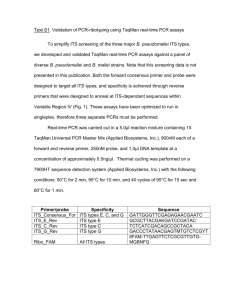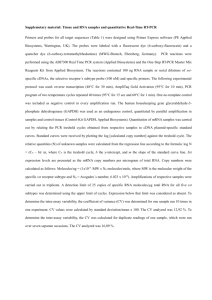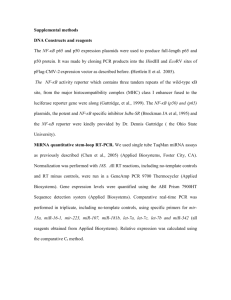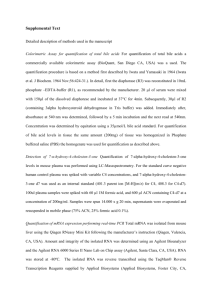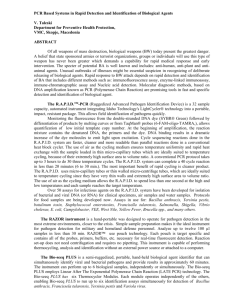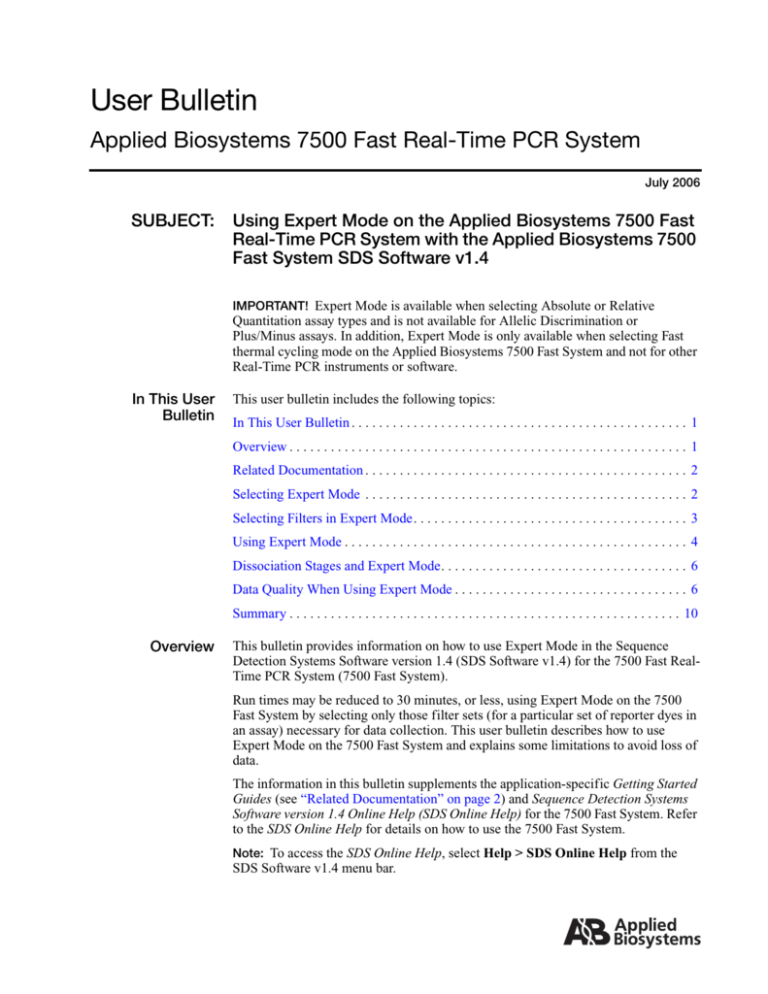
User Bulletin
Applied Biosystems 7500 Fast Real-Time PCR System
July 2006
SUBJECT:
Using Expert Mode on the Applied Biosystems 7500 Fast
Real-Time PCR System with the Applied Biosystems 7500
Fast System SDS Software v1.4
IMPORTANT! Expert Mode is available when selecting Absolute or Relative
Quantitation assay types and is not available for Allelic Discrimination or
Plus/Minus assays. In addition, Expert Mode is only available when selecting Fast
thermal cycling mode on the Applied Biosystems 7500 Fast System and not for other
Real-Time PCR instruments or software.
In This User
Bulletin
This user bulletin includes the following topics:
In This User Bulletin . . . . . . . . . . . . . . . . . . . . . . . . . . . . . . . . . . . . . . . . . . . . . . . . . 1
Overview . . . . . . . . . . . . . . . . . . . . . . . . . . . . . . . . . . . . . . . . . . . . . . . . . . . . . . . . . . 1
Related Documentation . . . . . . . . . . . . . . . . . . . . . . . . . . . . . . . . . . . . . . . . . . . . . . . 2
Selecting Expert Mode . . . . . . . . . . . . . . . . . . . . . . . . . . . . . . . . . . . . . . . . . . . . . . . 2
Selecting Filters in Expert Mode. . . . . . . . . . . . . . . . . . . . . . . . . . . . . . . . . . . . . . . . 3
Using Expert Mode . . . . . . . . . . . . . . . . . . . . . . . . . . . . . . . . . . . . . . . . . . . . . . . . . . 4
Dissociation Stages and Expert Mode. . . . . . . . . . . . . . . . . . . . . . . . . . . . . . . . . . . . 6
Data Quality When Using Expert Mode . . . . . . . . . . . . . . . . . . . . . . . . . . . . . . . . . . 6
Summary . . . . . . . . . . . . . . . . . . . . . . . . . . . . . . . . . . . . . . . . . . . . . . . . . . . . . . . . . 10
Overview
This bulletin provides information on how to use Expert Mode in the Sequence
Detection Systems Software version 1.4 (SDS Software v1.4) for the 7500 Fast RealTime PCR System (7500 Fast System).
Run times may be reduced to 30 minutes, or less, using Expert Mode on the 7500
Fast System by selecting only those filter sets (for a particular set of reporter dyes in
an assay) necessary for data collection. This user bulletin describes how to use
Expert Mode on the 7500 Fast System and explains some limitations to avoid loss of
data.
The information in this bulletin supplements the application-specific Getting Started
Guides (see “Related Documentation” on page 2) and Sequence Detection Systems
Software version 1.4 Online Help (SDS Online Help) for the 7500 Fast System. Refer
to the SDS Online Help for details on how to use the 7500 Fast System.
Note: To access the SDS Online Help, select Help > SDS Online Help from the
SDS Software v1.4 menu bar.
Applied Biosystems 7500 Fast Real-Time PCR System
Related
Documentation
For more information about using the 7500 Fast System and SDS Software v1.4,
refer to:
• Applied Biosystems 7300/7500/7500 Fast Real-Time PCR System Absolute
Quantitation Getting Started Guide (PN 4347825)
• Applied Biosystems 7300/7500/7500 Fast Real-Time PCR System Relative
Quantitation Getting Started Guide (PN 4347824)
• Sequence Detection Systems Software version 1.4 Online Help (SDS Online
Help)
Selecting Expert
Mode
To select Expert Mode in SDS Software v1.4:
1. Set up your plate document as explained in the appropriate Getting Started
Guide or SDS Online Help.
2. At the Instrument tab, verify that Expert Mode is selected. Click the
Select/View Filters button.
Note: Expert Mode is only enabled for the Fast 7500 thermal cycling Run
Mode. This feature is not available for Standard or 9600 Emulation mode.
Instrument Tab
Expert Mode
selected
2
Select/View
Filters Button
User Bulletin
1. At the Filter Selection (Expert Mode) dialog box, select the desired filters.
2. (Optional) To rename the filter labels, select Tools > Filter Configuration to
open the Filter Naming dialog box. You can change Filter names to indicate the
reporter dyes calibrated for the instrument.
Selecting Filters
in Expert Mode
Using Expert Mode, you can select any single filter or group of filters for data
collection. However, when using ROX™ as a passive reference dye, you must use
certain combinations of filters (see Table 1). All Applied Biosystems’ master mixes
contain ROX™ as a passive reference dye to correct for fluorescent fluctuations
which may occur during the run (due to bubbles or variations resulting from
pipetting error). Using ROX™ as a passive reference dye, in all runs, is strongly
recommended.
Table 1
Filter selection options with or without ROX™ dye passive reference
Reporter Dye/Assay Type
Filter Selection
with ROX™ Dye
Passive Reference
Normalization
Filter Selection
without ROX™ Dye
Passive Reference
Normalization
FAM™ Single Reporter Assay (using
non-fluorescent quencher)
A, D
A
FAM™ Single Reporter Assay (using
TAMRA quencher)
A, C, D
A, C
SYBR® Green I Dye
A, D
A
VIC® Single Reporter Assay
(using non-fluorescent quencher)
A a, B, D
B
Using Expert Mode on the Applied Biosystems 7500 Fast Real-Time PCR System with the Applied Biosystems 7500 Fast
System SDS Software v1.4
3
Applied Biosystems 7500 Fast Real-Time PCR System
Reporter Dye/Assay Type
Filter Selection
with ROX™ Dye
Passive Reference
Normalization
Filter Selection
without ROX™ Dye
Passive Reference
Normalization
VIC® Single Reporter Assay
(using TAMRA quencher)
Aa, B, C, D
B, C
NED™ Single Reporter Assay
(using non-fluorescent quencher)
Aa, C, D
C
Cy3 Single Reporter Assay
(using non-fluorescent quencher)
Aa, C, D
C
Cy5 Single Reporter Assay
(using non-fluorescent quencher)
Aa, D, E
E
FAM™/VIC® Multiplex Assay
(using non-fluorescent quencher for
both FAM™/VIC® reporters)
A, B, D
A, B
FAM™/VIC® Multiplex Assay
(using TAMRA® quencher for both
FAM™/VIC® reporters)
A, B, C, D
A, B, C
a. When using Applied Biosystems Master Mixes, both FAM and ROX™ dye filters are required
for correct use of the ROX™ dye passive reference normalizer.
IMPORTANT! Selecting the incorrect filter for a particular assay (i.e., Filter C for a
FAM dye single reporter assay) results in loss of data for that experiment, since no
data will be collected for the FAM® dye in filter A.
Using Expert
Mode
Thermal Cycling Modes on 7500 Fast Systems
The 7500 Fast System has three thermal cycling run modes equating to three
different sample temperature ramp rates. The run mode options are Fast, Standard
and 9600 Emulation modes.
Fast thermal cycling mode attains sample ramp rates of +/- 3.5 °C/sec (up and down
ramp). Standard mode attains +/-1.6 °C/sec. The 9600 Emulation mode matches the
sample ramp rate achieved for the ABI PRISM® 7700 Sequence Detection System at
up ramp of 0.8 °C/sec and down ramp of 1.6 °C/sec, ensuring assays that were
designed for older generation platforms achieve comparable performance on newer
systems.
Extension Times for Fast Thermal Cycling Protocols
Fast thermal cycling run mode, in combination with TaqMan® Fast Universal PCR
Master Mix (2✕) No AmpErase UNG and Optical Fast Thermal Cycling plates,
allows a reduction in thermal cycling protocols to approximately 40 minutes.
4
User Bulletin
The default Fast thermal cycling protocol uses a denaturation time of 3 seconds at
95 °C and an extension time of 30 seconds at 60 °C. The requirement for a 30 second
extension time results from the time required to collect data through all 5 filters plus
the time needed for the master mix enzyme to complete the polymerization process.
Fast Thermal Cycling Protocol Time
(Expert Mode Not Selected)
Expert Mode Thermal Cycling Time
(Expert Mode Selected)
When Expert Mode is selected, the default extension time changes to 20 seconds.
This is the minimum recommended extension time (when using TaqMan® Fast
Universal PCR Master Mix (2✕) No AmpErase® UNG) needed for the
polymerization process to complete. If you are selecting fewer than 2 filters for data
collection, you may optionally choose to select extension times lower than 20
seconds. However, note that extension times of less than 20 seconds have not been
validated using TaqMan® Fast Universal PCR Master Mix (2✕) No AmpErase UNG
and may impact the quality of results. Validating your assay performance, when
using extension times of less than 20 seconds, is therefore strongly recommended.
At the start of each run, the SDS Software verifies the extension time, as set by the
user, against the number of filters selected. If the minimum time needed to collect
data through the selected number of filters exceeds the extension time, the SDS
Software will generate a warning message that the run cannot be started. You must
then enter a longer extension time to allow for the data collection process to
complete and the run to be started. Refer to the table below for the minimum required
extension times in relation to the number of filters selected.
Using Expert Mode on the Applied Biosystems 7500 Fast Real-Time PCR System with the Applied Biosystems 7500 Fast
System SDS Software v1.4
5
Applied Biosystems 7500 Fast Real-Time PCR System
Table 2
Minimum extension times for filter selections in Expert Mode
Number of Filters Selected
Minimum Extension Time/Seconds a
Default
20 b
1
10 c
2
14
3
19
4
23
5
25
a. Note that the minimum times listed may vary slightly by 1 - 2 seconds for different
combinations of filters and from instrument to instrument.
b. The default extension time is set at 20 seconds for all Expert Mode filter selections. This
selection can be modified by the user, however, to avoid observable data quality issues
(related to extension times) it is strongly recommended that the default time be used.
c. In Expert Mode, these times are the absolute minimum extension times needed for the
number of filters selected.
Dissociation
Stages and
Expert Mode
Dissociation stages are typically added to real time PCR runs when using SYBR®
Green I dye as the reporter dye. If you use Expert Mode and add a dissociation stage
to the thermal cycling protocol, dissociation data is only collected for those filters
selected using Expert Mode. The number of data points collected during dissociation
varies depending on the number of filters selected. As the number of filters selected
decreases, the number of data points collected during the dissociation stage
increases.
Applied Biosystems does not currently provide a SYBR® Green I Dye master mix
which can be used for runs in Fast thermal cycling mode. It is strongly recommended
that Standard or 9600 emulation modes be selected for all runs using Applied
Biosystems SYBR® Green I Dye containing master mixes.
Data Quality
When Using
Expert Mode
Data quality, when using Expert Mode (with a 20 second extension time) is generally
comparable to data obtained using Fast Mode (with a 30 second extension time).
Note that when using Expert Mode, ∆Rn values will decrease since less time is
allowed for the extension phase of the reaction. This results in an overall decrease in
fluorescent signal. It is strongly recommended that you keep the default extension
time (of 20 seconds in Expert Mode) as the minimum extension time used for any
assay. Extension times below 15 seconds are known to significantly impact the CT
and precision of data sets.
Two experiments were performed to compare the CT values and precision of data
generated using Expert Mode and Fast Mode:
• A TaqMan® RNase P Instrument Verification Plate assay was run quantitating a
genomic DNA target against a standard curve.
• A selection of TaqMan® Gene Expression assays were run using cDNA as a
template.
6
User Bulletin
Comparing TaqMan® RNase P Data Between Expert Mode and Fast Mode
The following section lists experimental conditions for running a TaqMan® RNase P
Instrument Verification Plate.
Expert Mode
Figure 1 Expert Mode Run. Fast RNase P Instrument Verification plate run on
7500 Fast Real-Time PCR System with default thermal cycling parameters for
Expert Mode (95 °C for 20 seconds, 40 cycles at 95 °C for 3 seconds, 60 °C for 20
seconds) using filters A and D (FAM™ and ROX™ dye) were used. Instrument run
time was 30 minutes.
Fast Mode
Figure 2 Fast Mode Run. Fast RNase P Instrument Verification plate run on
7500 Fast Real-Time PCR System with default thermal cycling parameters for
Fast Mode (95 °C for 20 seconds, 40 cycles at 95 °C for 3 seconds, 60 °C for 30
seconds). Data was collected through all filters. Instrument run time was 40
minutes.
Using Expert Mode on the Applied Biosystems 7500 Fast Real-Time PCR System with the Applied Biosystems 7500 Fast
System SDS Software v1.4
7
Applied Biosystems 7500 Fast Real-Time PCR System
The table below compares the results of Expert Mode and Fast Mode and shows that
the precision of data for the RNase P assay is comparable between Expert Mode and
Fast Mode.
Table 3
Results summary for RNase P instrument verification plate
TaqMan® RNase P Instrument
Verification Plate
Expert Mode
Fast Mode
5K Unknown Standard Deviation
0.061
0.079
10K Unknown Standard Deviation
0.058
0.090
R2 Value for Standard Curve
0.997
0.995
Comparing Data Quality Between Expert Mode and Fast Mode for TaqMan®
Gene Expression Assays
The following section lists experimental conditions for running eight TaqMan® Gene
Expression Assays in each Mode. The eight assays are listed below.
Table 4
List of assays used
Gene Symbol
Assay ID
PGRMC1
Hs00198499_m1
RAB14
Hs00249440_m1
SRM
Hs00162307_m1
RAB12
Hs00407832_m1
CCT7
Hs00362446_m1
Beta-2M
4333766F
TGF-beta
4327054F
RNase P
-
The following experimental conditions were used for both Expert and Fast modes.
Table 5
8
Experimental conditions
Condition
Expert Mode
Fast Mode
Replicates
10 Replicates plus 2 NTCs (No
Template Controls) for each assay
10 Replicates plus 2 NTCs (No
Template Controls) for each assay
Reagents
TaqMan®Fast Universal PCR
Master Mix (2✕), No AmpErase
UNG
TaqMan®Fast Universal PCR
Master Mix (2✕), No AmpErase
UNG
Reaction
Volume
20 µL
20 µL
User Bulletin
Data
Collection
Filters A & D
Filters A, B, C, D, E
Plate
Optical 96-well Fast Thermal
Cycling Plate with Barcode (code
128)
Optical 96-well Fast Thermal
Cycling Plate with Barcode (code
128)
Thermal
Cycling
Parameters
Hold: 20 sec/95 °C
40 Cycles: 3 sec/95 °C
then 20 sec/60 °C
Hold: 20 sec/95 °C
40 Cycles: 3 sec/95 °C
then 30 sec/60 °C
CHEMICAL HAZARD. TaqMan® Fast Universal PCR Master Mix
(2✕), No AmpErase UNG may cause eye and skin irritation. Exposure may cause
discomfort if swallowed or inhaled. Read the MSDS, and follow the handling
instructions. Wear appropriate protective eyewear, clothing, and glove.
The results for both runs are listed in the table below and the comparable
amplifications plot appear in “Amplification plots” on page 10.
Table 6
Experimental results
Expert Mode
Fast Mode
Gene
Average CT
Standard
Deviation
Average CT
Standard
Deviation
PGRMC1
28.14
0.031
27.95
0.068
RAB14
25.75
0.048
25.36
0.031
SRM
23.11
0.038
23.00
0.061
RAB12
25.40
0.047
25.28
0.043
CCT7
23.05
0.114
22.64
0.108
Beta-2M
21.00
0.040
20.95
0.043
TGF-beta
24.73
0.075
24.66
0.088
RNase P
18.78
0.063
18.67
0.083
Using Expert Mode on the Applied Biosystems 7500 Fast Real-Time PCR System with the Applied Biosystems 7500 Fast
System SDS Software v1.4
9
Applied Biosystems 7500 Fast Real-Time PCR System
Table 7
Amplification plots
Figure 3 Expert Mode Run. Eight
TaqMan® Gene Expression assays
run on 7500 Fast System using filters
A and D for FAM and ROX dyes with
20 second extension time (see Table 5
on page 8 for experimental
conditions)
Summary
10
Figure 4 Fast Mode Run. The same
eight ® Gene Expression assays run
on 7500 Fast System using with data
collected through all filters with 30
second extension time (see Table 5
on page 8 for experimental
conditions)
Expert Mode, on the 7500 Fast System provides the capability to reduce run times to
30 minutes while maintaining data quality comparable to that obtained using Fast
thermal cycling mode.
User Bulletin
Using Expert Mode on the Applied Biosystems 7500 Fast Real-Time PCR System with the Applied Biosystems 7500 Fast
System SDS Software v1.4
11
© Copyright 2006, Applied Biosystems. All rights reserved.
For Research Use Only. Not for use in diagnostic procedures.
Information in this document is subject to change without notice. Applied Biosystems assumes no
responsibility for any errors that may appear in this document.
APPLIED BIOSYSTEMS DISCLAIMS ALL WARRANTIES WITH RESPECT TO THIS DOCUMENT,
EXPRESSED OR IMPLIED, INCLUDING BUT NOT LIMITED TO THOSE OF MERCHANTABILITY OR
FITNESS FOR A PARTICULAR PURPOSE. IN NO EVENT SHALL APPLIED BIOSYSTEMS BE LIABLE,
WHETHER IN CONTRACT, TORT, WARRANTY, OR UNDER ANY STATUTE OR ON ANY OTHER
BASIS FOR SPECIAL, INCIDENTAL, INDIRECT, PUNITIVE, MULTIPLE OR CONSEQUENTIAL
DAMAGES IN CONNECTION WITH OR ARISING FROM THIS DOCUMENT, INCLUDING BUT NOT
LIMITED TO THE USE THEREOF.
Notice to Purchaser: License Disclaimer
Purchase of this software product alone does not imply any license under any process, instrument or
other apparatus, system, composition, reagent or kit rights under patent claims owned or otherwise
controlled by Applera Corporation, either expressly or by estoppel.
Worldwide Sales and Support
Applied Biosystems vast distribution and
service network, composed of highly trained
support and applications personnel,
reaches 150 countries on six continents.
For sales office locations and technical support,
please call our local office or refer to our
Web site at www.appliedbiosystems.com.
Applera is committed to providing the
world’s leading technology and information
for life scientists. Applera Corporation
consists of the Applied Biosystems and
Celera Genomics businesses.
TRADEMARKS:
AB (Design), Applied Biosystems, ABI PRISM, and VIC are registered trademarks and Applera, FAM,
NED, ROX, and TAMRA are trademarks of Applera Corporation or its subsidiaries in the U.S. and/or
other countries.
TaqMan and AmpErase UNG are registered trademarks of Roche Molecular Systems, Inc.
All other trademarks are the sole property of their respective owners.
Headquarters
850 Lincoln Centre Drive
Foster City, CA 94404 USA
Phone: +1 650.638.5800
Toll Free (In North America): +1 800.345.5224
Fax: +1 650.638.5884
07/2006
www.appliedbiosystems.com
Part Number 4367499 Rev. B
Stock Number 117UB14-02

